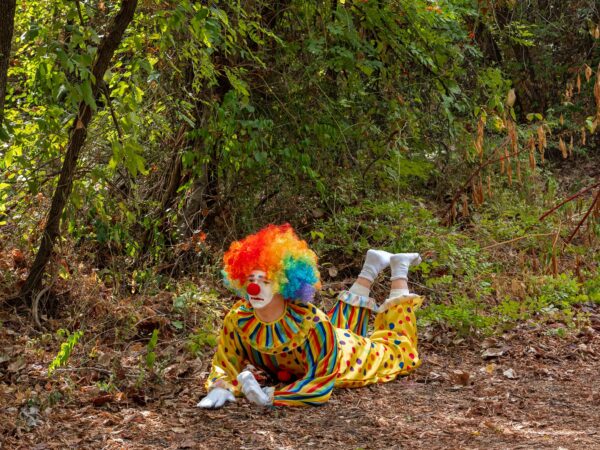
Ryan Hawk, “Outside Agitator (All Artists Are Bastards),” 2023, silicone rubber, foam, makeup, clown costume, and other various materials, 72 x 30 x 40 inches. Photo: Ryan Hawk
Sweet Pass Sculpture Park is a scrappy one-acre lot in West Dallas in the elbow of a small road, backed by railroad tracks and an abandoned lot to its left. It is an unkempt piece of land with a grassy open space, trees, and a path leading to a small house at the back. The sculpture park is a “permanent space for temporary projects,” as described on its website, “situated in the gap between gardens, green spaces, and public spaces.” There is a tall chain link gate and fence at the front, with a hefty metal chain looped around the gates. Artists Anna Mayer, Jillian Conrad, and I ventured to the sculpture park to see Ryan Hawk’s outdoor solo exhibition, a long leash. Hawk was inside and came to open up. The park wasn’t officially open that weekend, but he had come to fix a sculpture after a North Texas storm, so he accommodated our visit.
I have known Hawk since he was a Core Fellow (2018-2020) at the Museum of Fine Arts, Houston, where I teach at the Glassell Studio School. He showed two very memorable videos as part of the Core exhibitions and also at Lawndale in Houston, where he had a show in 2019. The protagonist in his Lawndale video stood at the front of a small conference room, alone, singing karaoke while slowly shuffling. A third, naked leg protruded between the character’s clothed legs. The work was creepy and poignant, funny and touching.
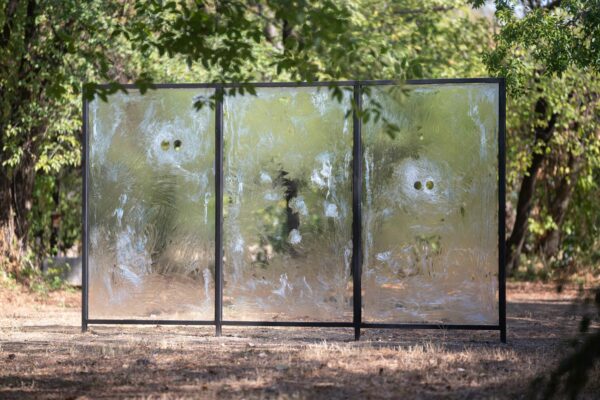
Ryan Hawk, “Untitled (front 1),” 2023, salvaged commercial window panels, silicone rubber, steel, and cement, 144 x 8 x 80 inches. Photo: Trey Burns
So here was Hawk opening up for us, letting us into the park on a fresh and sunny day. Mayer and Conrad headed over to a pile of bricks on a pallet to the right of the entry gates. Hawk wandered off and looked like he was talking to someone behind some trees as he crouched on the ground. In front of me was what in this semi-rural setting felt like a blind, maybe for military training exercises or paintballing: it was made up of three semi-transparent panels of glass in black metal frames that stood about six inches off the ground. Like a long cubicle partition, 8 feet tall and 12 feet wide. Each end panel had two imperfect, eye-width circular cutouts, like two peep-holes (or shoot holes). A semitransparent schmear of clear silicone caulk on the glass was smeared like grease or lard into more fog-like density around the holes, making two ghostlike faces — present, but not present. Up-close, you did not really want to lean in close enough to put your eyes to the holes. The silicon made the surface gross, bodily, unsettling, and strangely sexual. One set of peepholes was adult height, the other at about five feet, maybe the height of an eight year old. The piece is titled Untitled (front 1). According to the dictionary, a front is “the side or part of an object that presents itself to view or that is normally seen or used first; the foremost line or part of an armed force.” In Hawk’s sculpture, the front suggested a place to hide behind, a place to spy and view, but also a place where we are fully seen, maybe in our shame, smeared and foggy.
I walked toward where Hawk had been talking to someone behind the trees. On the ground was a person dressed as a clown, with a painted white face and red nose, wearing a tie-dye curly wig, a clown suit, and white socks and gloves. He was lying on his stomach, with his legs bent upward as if he was watching TV or lounging on someone’s living room floor. But here he was in the middle of the woods, on the dirty ground, incongruous in his white socks and clean, bright, multicolored striped and dotted suit. One gloved hand was flat on the ground and the other was raised, fingers slightly curled, in a gesture of attention or contemplation. He was not moving.
For a few seconds I did a double take, imagining that Hawk had hired an actor to perform as part of the exhibition, but as I came closer I could see this was instead a lovingly crafted sculpture. Where the flesh was exposed between the figure’s glove and cuff and hem and socks, there was white skin covered in arm and leg hair; he was completely lifelike, but not alive or breathing. It took my breath away. There is such a deep vulnerability to this made figure lying in the dirt and leaves in his clown suit. I am not scared of clowns and this was not a scary clown, but even so this encounter stirred up an array of emotions — it was deeply unsettling and also gentle, funny, and tender.
This clown seemed out of tricks, contemplative and somewhat forlorn, on a break from his clowning life. He looked familiar under the white makeup. It took me a while to realize that Hawk had cast himself, the artist, as protagonist in his own exhibition, dressed-up as a clown, an impostor, a fool, an incongruous dreamer, laid bare by the sculpture’s title: Outside Agitator (All Artists are Bastards). Lying on the ground, this agitator seemed absorbed in himself, his dreams, maybe ineffectual as a political actor, however at the same time he was powerfully affective. Not a bastard, I would say.
I walked away from the clown, around the gently curved path, and re-entered the open area at the back of the park to find a tall vertical sculpture where a fire pit in a campsite might be — a little secluded. Out of a dug dirt pit rose a column of head-shaped balaclava masks stacked upright, one on top of the other, appearing like slightly goopy black knitted baskets. The masks were of the kind a bank robber might wear during a heist or a protester might wear as black bloc. Toward the top of the column one of these hollow heads was upside down, touching the one underneath with the crown of its head; the next few heads were stacked upright again. The masks were all hollow, with open holes for eyes and mouths, their interiors seemingly unreinforced. This sculpture, titled a heady deconstruction of the object and representation, seemed a word play of sorts: we were looking at a physical construction of these “objects of representation,” their punned “heady-ness” nodding at the art world’s retreat into the at times obscure and academic. Simultaneously, the title is laughing at its own complicity. Indeed, the stacked heads felt the opposite of heady or deconstructed; the work was visceral, eye and mouth holes crying out with emptiness, a vertical totemic sculpture staking ground in a ritualized backyard act.
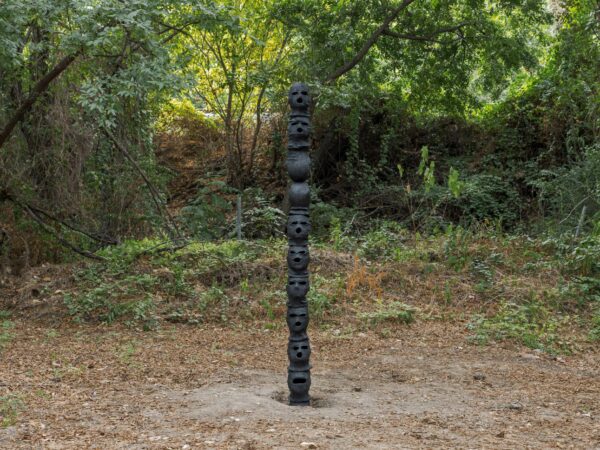
Ryan Hawk, “a heady deconstruction of the object and representation,” 2023, black balaclavas, resin, epoxy, hardware,
12 x 8 x 120 inches. Photo: Ryan Hawk
Artworks that were stacking in my mind as I experienced these pieces were Bruce Nauman’s clown videos and stacked heads, Brancusi’s endless column, Matthew Barney’s smeared surfaces, Robert Gober’s waxy morphous bodies, and the uncanny precision of Duane Hanson’s lifelike sculptures. Hawk had said there was a video installation in the house, so I walked toward the far back of the property where a wooden wheelchair ramp led up to a small green ramshackle building by the railroad tracks. Walking in was disorientating. It felt like I was stepping into a closet; the space was dark and illuminated only by the video screen of a small TV on the floor that had been turned away and reflected back at me in a couple of mirrors. Contributing to the atmosphere was some glowing wall text and a red light.
It was loud in the room; the video’s sounds of gunfire and explosions made the space claustrophobic. The video showed spliced-together scenes of violence, shootouts, and explosions from iconically recognizable movies. It was creepy and violent watching shooting after shooting, cop cars bursting in through windows. The video, Squib (the production of indifference), might be producing indifference to violence, but it is also exposing it. In film production, squibs are the detonators that fire out of someone’s clothes to show they’re shot. Sometimes they’re connected to pulsing fake blood, meaning they’re responsible for simulating the violence of the scene. Tellingly, a squib is also a piece of satirical writing. The indirectness of viewing Hawk’s video somehow transformed something that might have felt literal into something obliquely resonant. I wanted to get out of the room and did not stay for the piece’s full six minutes.
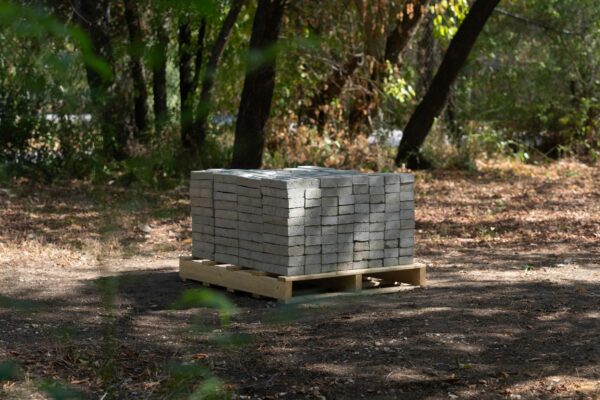
Ryan Hawk, “takeaway/throwaway,” 2023
wooden pallet, approx 400 custom 3 5/8 x 2 ¼ x 8 inch concrete bricks (to be taken by viewers), 40 x 48 x 40 inches. Photo: Trey Burns

Ryan Hawk, “one brick from takeaway/throwaway,” 2023, concrete, 3 5/8 x 2 ¼ x 8 inches, Photo: Ryan Hawk
I walked back through the woods, past the balaclava masks, the “front,” and the clown, toward the pile of bricks on a wooden pallet near the front gate. Walking up to takeaway/throwaway, I could see the bricks were handmade, cast from concrete rather than clay, a raised tuning fork depicted on each one. We were allowed to take one home, said Hawk. I am always a taker of free swag made by artists, so I picked one up. It felt hefty in my hand. The cast of the tuning fork on the front was delicate, a little chipped. A beautiful object. Concrete brick in hand, I walked out and back to the car, ready to smash something with its heft or contemplate the brick’s mute and encased sound. The brick now sits on my bookshelves, part bookend, part sculpture, part souvenir of this succinct and beautiful show.
The show closes this Saturday, November 18. It is truly worth the trip to walk through this very site-specific, beautifully considered, and deeply affecting exhibition. The title, a long leash, references the CIA operation “long leash,” which aimed to bolster American cultural dominance during the Cold War with a plan to relocate the cultural center of the West to the U.S. and New York. Hawk keeps us on a long leash as we walk through the woods, making connections, stretching the ties between things and then snapping us back. The sculptures in the exhibition would be coherent and powerful in any white cube gallery setting, but oh!, they are so much more resonant embedded and hidden in the dirt and decaying leaves, camouflaged into whole other layers of meaning.
Ryan Hawk: a long leash is on view at Sweet Pass Sculpture Park (402 Fabrication St, Dallas, TX) through November 18, 2023.
***
Francesca Fuchs is an artist and educator who writes descriptions of her own work and occasionally writes descriptions of other artist’s work or projects. Her last piece of writing was a description of Felipe Steinberg’s An Opening in a defunct theater space in Houston, published by Nathaniel Donnett’s in his no longer active online project NotThatButThis.com. You can still read this piece here. For more writing about Hawk’s show, see Trey Burns’ essay in the exhibition handout.


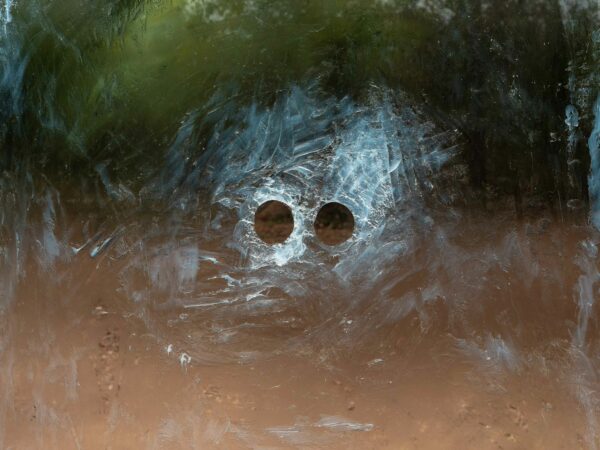


2 comments
Once again I lament that we don’t have bullet trains in TX. I would love to see this show.
Francesca, please continue to share your writing! I thoroughly enjoyed reading about your experience of Ryan Hawk’s outdoor, site-specific exhibition. Thoughtful exhibitions like these should get more public attention, and it’s great to see Houston artists traveling and having conversations with communities in other cities across TX like Dallas.